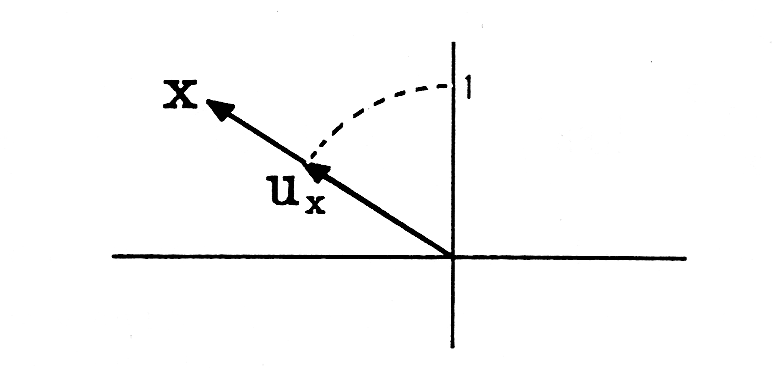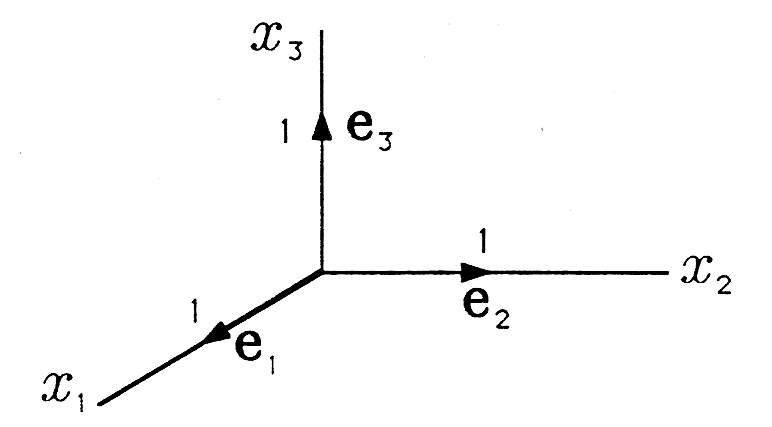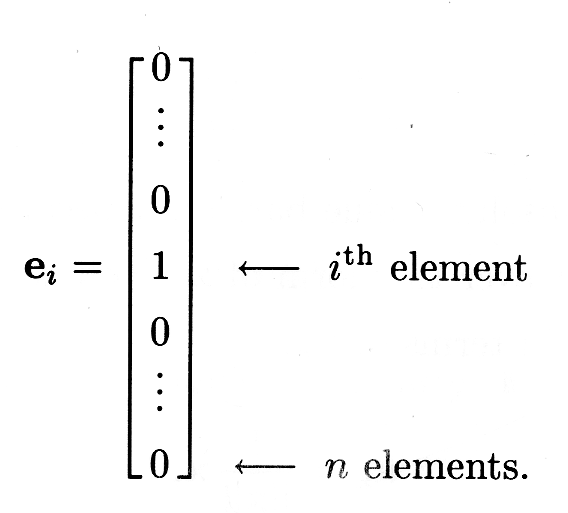| << Chapter < Page | Chapter >> Page > |
Unit Vectors. Corresponding to every vector is a unit vector pointing in the same direction as . The term unit vector means that the norm of the vector is 1:
The question is, given , how can we find ? The first part of the answer is that will have to be a positive scalar multiple of in order to point in the same direction as , as shown in [link] . Thus

But what is ? We need to choose so that the norm of will be 1:
We have dropped the absolute value bars on because is positive. The that does the job is 1 over the norm of . Now we can write formulas for in terms of and in terms of :
So the vector is its direction vector , scaled by its Euclidean norm.
Unit Coordinate Vectors. There is a special set of unit vectors called the unit coordinate vectors. The unit coordinate vector is a unit vector in that points in the positive direction of the coordinate axis. [link] shows the three unit coordinate vectors in .

For three-dimensional space, , the unit coordinate vectors are
More generally, in n-dimensional space, there are unit coordinate vectors given by

You should satisfy yourself that this definition results in vectors with a norm of l.
Direction Cosines. We often say that vectors “have magnitude and direction.” This is more or less obvious from "Linear Algebra: Vectors" , where the three-dimensional vector has length and points in a direction defined by the components , and . It is perfectly obvious from [link] where is written as . But perhaps there is another representation for a vector that places the notion of magnitude and direction in even clearer evidence.
[link] shows an arbitrary vector and the three-dimensional unit coordinate vectors . The inner product between the vector and the unit vector just reads out the component of :
Since this is true even in , any vector has the following representation in terms of unit vectors:
![Figure four is a three-dimensional graph with four vectors and measured angles between the vectors. Along the axis that moves towards the screen is the vector e_1, [1 0 0]. Along the axis moving up the page is the vector e_3, [0 0 1]. The angle between e_1 and e_3 is labeled θ_1. A third vector is drawn along the axis that moves to the right, and is labeled e_2 [0 1 0]. The angle between e_2 and e_3 is labeled θ_2. A fourth and final vector is drawn in the positive e_1 e_2 and e_3 directions, and is labeled x. The magnitude of x is labeled as ||x||. The angle between x and e_3 is labeled as θ_3. The angle between the projection of x onto the e_1 e_2 axis and the vector e_1 is labeled Φ.](/jc2012-war/ocw/mirror/col10685_1.2_complete/m21449/pic007.png)
Let us now generalize our notion of an angle between two vectors to as follows:
The celebrated Cauchy-Schwarz inequality establishes that cos . With this definition of angle, we may define the angle that a vector makes with theunit vector to be
But the norm of is 1, so
When this result is substituted into the representation of x in [link] , we obtain the formula
This formula really shows that the vector has “magnitude” and direction and that the magnitude and direction are sufficient to determine . We call ( , cos , cos ) the direction cosines for the vector . In the three-dimensional case, they are illustrated in [link] .
If we compare [link] and [link] we see that the direction vector is composed of direction cosines:
With this definition we can write [link] compactly as
Here is written as the product of its magnitude and its direction vector . Now we can give an easy procedure to find a vector's direction angles:
(i) find ;
(ii) calculate ; and
(iii) take the arc cosines of the elements of .
Step (iii) is often unnecessary; we are usually more interested in the direction vector (unit vector) u x . Direction vectors are used in materials science in order to study the orientation of crystal lattices and in electromagnetic fieldtheory to characterize the direction of propagation for radar and microwaves. You will find them of inestimable value in your courses on electromagneticfields and antenna design.

Notification Switch
Would you like to follow the 'A first course in electrical and computer engineering' conversation and receive update notifications?